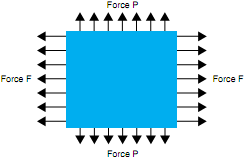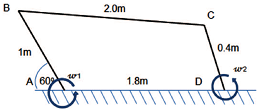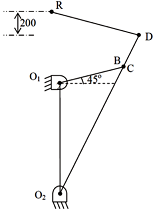Reference no: EM13993016
Part -1:
Question 1 (P1)
Air is heated from 18oC and 300 kPa in a fixed volume of 0.9m3. The final pressure is 700 kPa. Calculate the:
(i) The final temperature.
(ii) The mass of the air.
Question 2
1.2 dm3 of a gas is compressed from 1 bar and 25oC to 7 bar and 90oC. If R = 287j/kg K then calculate:
(i) The new volume
(ii)The mass of the gas
Question 3
In a closed system 0.3 kg of gas at 373 K is expanded isothermally and reversibly from 1MPa pressure to 200 kPa. Given that Cv= 718 j/kg K and R = 287 J/kg K
Determine
(i) The work done
(ii) State the energy transfer within this isothermal process explaining your answer.
(i)
p1 = 1MPa
p2 = 200kPa
V1 = 0.3 kg
V2 = ?
Question 4
0.05 kg of gas at 20 bar and 1100ºC is expanded reversibly to 2 bar by the law pV1.3 = C in a closed system.
(i) Determine the initial volume
(ii) Determine the final volume
(iii) Calculate the work done.
Question 5
a. An air compressor (open system) has air flowing at 0.04kg/s. The air is cooled from 100oC to 48oC in an intercooler. Calculate the heat transfer rate from the air given that cp = 1.005 kJ/kg K.
b. A gas turbine in the last example has jet thrusters on the exhaust that produce a velocity of 350m/s. Calculate the rate of work done power output from the shaft assuming that PE and the inlet velocity are negligible.*
Question 6
A coal burned in a furnace contains 90% C, 6.5% H2, 1.5% S and 2% ash.
Determine the stoichiometric air/fuel ratio for coal.
Question 7
A bomb calorimeter is used to determine the higher calorific value of an oil sample.
The mass of oil is 1.05g. The total equivalent mass of water is 1.42 kg. The increase in temperature after ignition is 8.2 K 1.9g of condensate is formed after it has cooled. Calculate the higher and lower calorific values if specific capacity of water is 4.186 kJ/kg K
Question 8
A superheater produces 28kg/s of steam at 65 bar and 380oC from steam 96% dry. Calculate the heat transfer rate to the steam.
Question 9
A steady flow boiler is supplied with water at 20 kg/s, 100 bar pressure and 200oC.
The water is heated and turned into steam. This leaves at 20 kg/s, 100 bar and 400oC. Using your steam tables, find:
(i) The specific enthalpy of the water entering.
(ii) The specific enthalpy of the water leaving.
(iii) The heat transfer rate.
Question 10:
Determine the thermal efficiency of a 60 MW output steam turbine supplied with 100 bar and 400oC steam. The steam exits turbine at 0.07 bar and dryness fraction 0.73. The flow rate of the steam is 45 kg/s.
Question 11:
Wet steam at 10 bar is throttled to 2 bar where its temperature is found to be 100oC. Determine the dryness fraction before throttling has taken place.
Part -2:
1. A test specimen metal wire of length 3.20 m has a percentage strain of 0.018% when loaded with a tensile force. Determine the extension of the wire.
2. A flat rectangular sheet of aluminium has width W=100 mm, length L = 200 mm and thickness t = 5 mm. A force F = 80kN is applied to the component as shown and is spread evenly all along the edge W.
Aluminium data:
Density = 2710 kg/m3 Tensile strength = 80 MPa
Yield strength = 50 MPa Elastic Modulus = 71 GPa
Poisson's ratio = 0.34

i Determine the stress in the direction of F
ii Determine the strain in the direction of F
iii Determine the change in length L and in thickness t. The component is now stretched in the direction of force P

iv Determine the change in W, L and t.
v Determine the change in the area of the plate
3. A rectangular hollow beam of length 3 m is simply supported at its ends. It has width 100 mm and depth 200 mm. The beam is subjected to a uniformly distributed load of 2 tonnes/m and a point load of 200N at its centre position.
Determine
i the maximum stress due to bending (occurring at the centre point)
ii the value of the radius of curvature of the neutral layer
iii the factor of safety if the maximum allowable stress of the material is 100 MPa.
4. A crank, rod and piston mechanism is shown below. The angle is measured clockwise from the horizontal. The mechanism has a crank of 50 mm radius which rotates at 3000 rpm.
i Determine the velocity of the piston for the position shown in the diagram.
ii Determine the angular velocity of link AB about A.

5 For the slider crank mechanism described in question 4 you must evaluate the output motion of the piston for compliance with the necessary conditions for simple harmonic motion.
i Explain clearly the conditions for simple harmonic motion.
ii Produce graphs for displacement, velocity and acceleration and from these evaluate whether the piston does exhibit simple harmonic motion explaining your answer in some detail.
6 Determine the angular velocity of the output linkage CD for the four-bar link mechanism shown here. The input link AB rotates at a constant speed of 600 rpm and note that this diagram has not been drawn here to scale.

7 A metal engineering component used in the erection of steel frames for buildings is a solid cube shape and has sides 170 mm. The component is compressed by a pressure of 60 MPa on each of its faces. Young's Modulus is 70 GPa and Poisson's ratio is 0.32.
i Determine the change in length of each side.
ii Determine the new volume and hence the change in volume of the cube.
8 Compare the effects on the load-carrying capacity of the beam in question 3 if it is altered by having its width increased by 25%.
9 Compare the effects on the load-carrying capacity of the beam in question 3 if it is altered by having its height increased by to 250 mm.
10 A shaft transmits power (60 kW) to a wheel causing it to rotate at 500 rpm. Determine
i the maximum shear stress of the circular steel shaft if the diameter is 25 mm
ii the factor of safety if the maximum allowable stress is 200 MPa
iii the angle of twist if G = 90 GPa and the length is 2 m.
(This question provides evidence for P3)
11 A mechanism generates a simple harmonic motion by following a circular motion and has its displacement described by the following equation:
x = R sin (ωt + ?)
Where the radius of motion R =14 mm, the angular velocity ω = 30 rad/s and the phase angle ? is 0.3 radian. At a time when t = 0.03 seconds determine the:
i Displacement
ii Velocity and
iii Acceleration of the mechanism when t = 0.02 seconds.
(This question provides evidence for P6)
12 A spring has a stiffness 30 kN/m and supports a mass of 8 kg. The mass is pulled so that the spring extends by amplitude of 10 mm and it is then released so that it produces linear oscillations.
i Determine the periodic time T, circular frequency ω, and natural frequency f.
ii Calculate the maximum velocity of the mass.
iii Calculate the maximum acceleration of the mass.
13 A pendulum has a string of length 80 mm long and is moved so that it makes a swinging oscillation. i Find the frequency f, angular frequency ω and the periodic time T for the pendulum.
ii If the initial movement makes an angle of 6º find how long it takes to move to a position 3º from the vertical.
(Question 12 and 13 provide evidence for P7)
14. A quick-return mechanism with a crank and a slotted lever are used within a shaping tool machine as shown below. The links have the following dimensions:
O1O2 = 900 mm O1B = 300 mm
O2D = 1300 mm DR = 400 mm
The crank O1B makes an angle of 45º with the vertical and rotates at an input velocity ω1 of 50 rpm in CCW direction (counterclockwise). See the configuration diagram below.
Determine:
i the velocity of ram R which is the velocity of the shaping tool
ii the output angular velocity of the link O2D which is ω2
(This question provides evidence for M3)

15 An internal combustion engine of 80 horsepower (hp) transmits power to the car wheels of an automobile at 300 rev/min (rpm). The shaft is a hollow tube of 0.0526 m external diameter and wall thickness 0.01 m. The maximum shear stress in the shaft is limited to 50 MPa.
i What will be the resulting angle of twist of the shaft, due to the applied torque, over a length of 1.8 m, given that the rigidity modulus, G = 70 Gpa? (Note that 1 hp = 745.7 W).
ii Compare the saving in weight and the reduced torque transmission capacity if the wall thickness is reduced by half.
(This question provides evidence for D1)
16 Data has been provided for a spring and weight hanger experiment.

i If mass M is pulled down from the rest position to produce vertical linear oscillations determine the frequency of vibration and the periodic time given that M = 50 g, spring stiffness k = 5 N/mm and Π = 3.14
Note: You must show all of your workings/calculations and provide your answers accurate to 3 decimal places.
ii It has been suggested that the spring mass slows down the actual oscillation of the mass and that a much more accurate result can be obtained if one third of the spring mass is added to mass M to correct the result.
The spring mass is measured at 15 g and when the frequency of vibration is accurately recorded under laboratory conditions it results in 0.048 Hz.
Recalculate your results with this correction and conclude whether the correction here is valid.